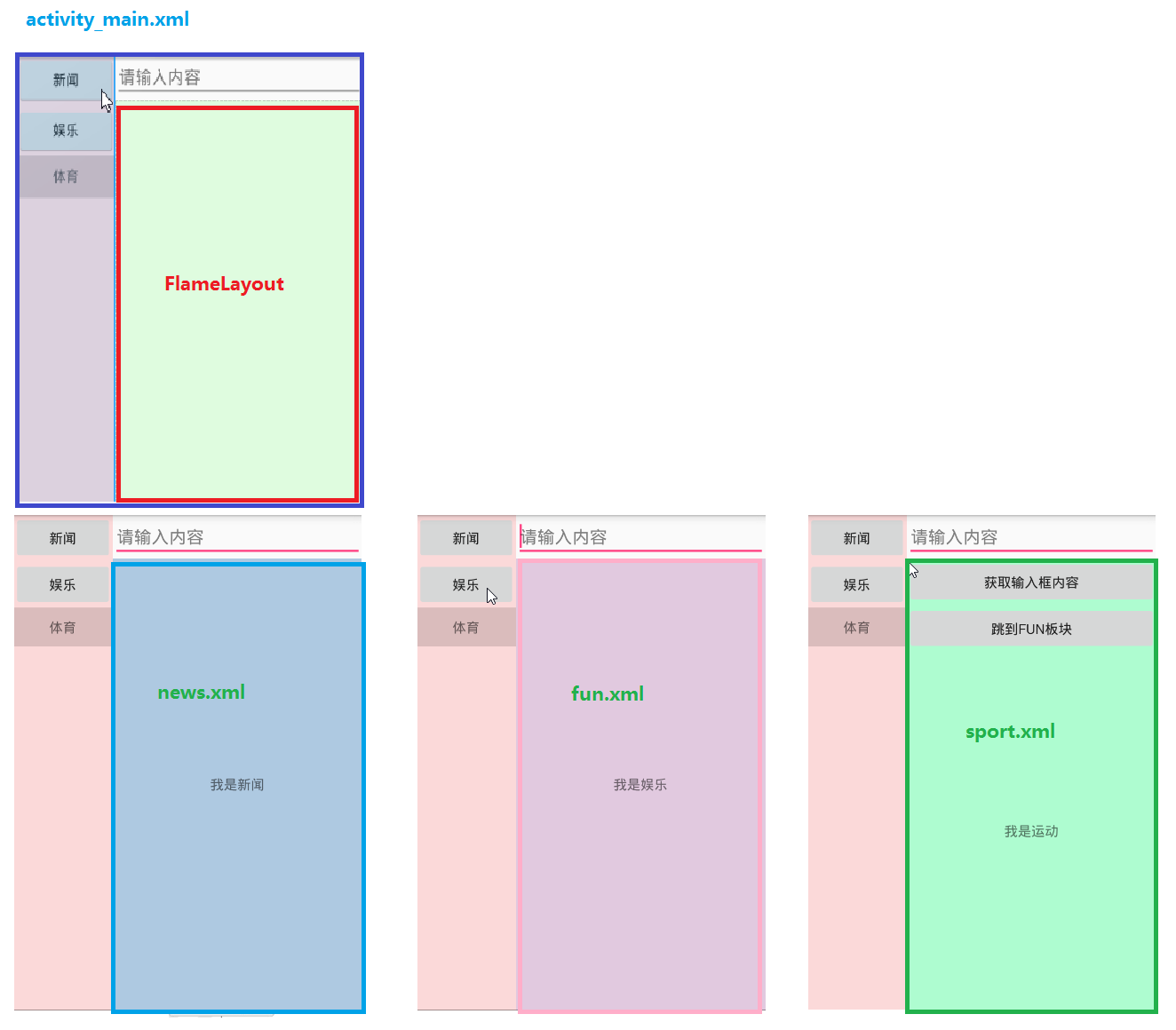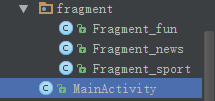"Fragment"-Android面試必問"精華技能點"彙總
阿新 • • 發佈:2018-12-30
Fragment技能點彙總總結:
目錄:
一.Fragment跟Activity如何傳值?
一.getActivity()
- 1.從Fragment獲取Ativity的資訊
- 2.就可以呼叫Ativity的方法了
二.setArguments(Bundle)
- 在Ativity獲取Fragment的例項和方法
過程和程式碼如下:
1.獲取管理者
FragmentManager fragmentManager = getFragmentManager();2.找到fragment
Fragment fragment = fragmentManager.findFragmentByTag(tag); Fragment fragment = fragmentManager.findFragmentById(id);3.一般直接管理物件.獲取事物(替換佈局,frgmentXX).提交.
- 可呼叫fragment的setArguments(bundle)把資料繫結到Fragment中.
- 為什麼官方推薦 Fragment.setArguments(Bundle bundle)這種方式來傳遞引數,而不推薦通過構造方法直接來傳遞引數呢? 請看以下兩個例子:
案例一:通過fragment構造傳給Activity
public class FramentTestActivity extends ActionBarActivity {
@Override
protected void onCreate 結果: 能正常顯示
當橫屏後:得到的值為null
案例二:換成setArguments(bundle)傳遞值
public class FramentTest2Activity extends ActionBarActivity {
@Override
protected void onCreate(Bundle savedInstanceState) {
super.onCreate(savedInstanceState);
setContentView(R.layout. activity_main);
if (savedInstanceState == null) {
getSupportFragmentManager().beginTransaction()
.add(R.id. container, TestFragment.newInstance("param")).commit();
}
}
public static class TestFragment extends Fragment {
private static final String ARG = "arg";
public TestFragment() {
Log. i("INFO", "TestFragment non-parameter constructor" );
}
public static Fragment newInstance(String arg){
TestFragment fragment = new TestFragment();
Bundle bundle = new Bundle();
bundle.putString( ARG, arg);
fragment.setArguments(bundle);
return fragment;
}
@Override
public View onCreateView(LayoutInflater inflater, ViewGroup container,
Bundle savedInstanceState) {
View rootView = inflater.inflate(R.layout. fragment_main, container,
false);
TextView tv = (TextView) rootView.findViewById(R.id. tv);
tv.setText(getArguments().getString( ARG));
return rootView;
}
}
}不論橫屏還是豎屏都會得到值
二.描述Fragment的生命週期
一.生命週期圖:
二.需求
- 1.螢幕分左右邊,左邊2/5是點選列表,右邊是:上輸入框,下文字框
- 2.最後一個內容fragment,多了個點選按鈕.並能獲取Activity裡的輸入框資訊.
- 3.效果圖如下圖1,2,3
三.程式碼:
佈局:
activity_main.xml
<?xml version="1.0" encoding="utf-8"?>
<LinearLayout
xmlns:android="http://schemas.android.com/apk/res/android"
android:layout_width="match_parent"
android:layout_height="match_parent"
android:orientation="horizontal"
>
<LinearLayout
android:layout_width="0dp"
android:layout_height="match_parent"
android:layout_weight="2"
android:background="#22ff0000"
android:orientation="vertical">
<Button
android:id="@+id/bt_news"
android:layout_width="match_parent"
android:layout_height="wrap_content"
android:text="新聞"/>
<Button
android:id="@+id/bt_fun"
android:layout_width="match_parent"
android:layout_height="wrap_content"
android:text="娛樂"/>
<TextView
android:id="@+id/tv_sport"
android:layout_width="match_parent"
android:layout_height="40dp"
android:background="#22000000"
android:gravity="center"
android:text="體育"/>
</LinearLayout>
<LinearLayout
android:orientation="vertical"
android:layout_width="0dp"
android:layout_weight="5"
android:layout_height="match_parent">
<EditText
android:id="@+id/et_info"
android:layout_width="match_parent"
android:hint="請輸入內容"
android:layout_height="wrap_content"/>
<FrameLayout
android:id="@+id/fl_content"
android:background="#2200ff00"
android:layout_width="match_parent"
android:layout_height="match_parent">
</FrameLayout>
</LinearLayout>
</LinearLayout>
fragment_fun.xml
<?xml version="1.0" encoding="utf-8"?>
<LinearLayout xmlns:android="http://schemas.android.com/apk/res/android"
android:layout_width="match_parent"
android:orientation="vertical"
android:layout_height="match_parent">
<TextView
android:background="#33ff00f7"
android:gravity="center"
android:text="我是娛樂"
android:layout_width="match_parent"
android:layout_height="match_parent"/>
</LinearLayout>
fragment_news.xml
android:background="#330000ff"
android:text="我是新聞"fragment_sport.xml
<Button
android:onClick="getInfo"
android:id="@+id/bt_getInfo"
android:text="獲取輸入框內容"
android:layout_width="match_parent"
android:layout_height="wrap_content"/>
<Button
android:onClick="goFun"
android:id="@+id/bt_goFun"
android:text="跳到Fun板塊"
android:layout_width="match_parent"
android:layout_height="wrap_content"/>
<TextView
android:gravity="center"
android:text="我是運動"
android:layout_width="match_parent"
android:layout_height="match_parent"/>Java程式碼:
(分類寫)
Fragment_fun.java
public class Fragment_fun extends Fragment {
//1.固定
@Override
public void onAttach(Context context) {
Log.d("abce", "onAttach");
super.onAttach(context);
}
//2.建立
@Override
public void onCreate(Bundle savedInstanceState) {
Log.d("abce", "onCreate");
super.onCreate(savedInstanceState);
}
//3.建立View
@Nullable
@Override
public View onCreateView(LayoutInflater inflater, ViewGroup container, Bundle savedInstanceState) {
Log.d("abce", "onCreateView");
//填充佈局進來
return inflater.inflate(R.layout.fragment_fun,null);
}
//4.建立活動介面
@Override
public void onActivityCreated(Bundle savedInstanceState) {
Log.d("abce", "onActivityCreated");
super.onActivityCreated(savedInstanceState);
}
@Override
public void onDestroyView() {
Log.d("abce", "onDestroyView");
super.onDestroyView();
}
@Override
public void onDestroy() {
Log.d("abce", "onDestroy");
super.onDestroy();
}
@Override
public void onDetach() {
Log.d("abce", "onDetach");
super.onDetach();
}
}
Fragment_news.java
@Override
public View onCreateView(LayoutInflater inflater, ViewGroup container, Bundle savedInstanceState) {
Log.d("abce", "onCreateView");
//填充佈局
return inflater.inflate(R.layout.fragment_news,null);
}Fragment_sport.java
@Override
public View onCreateView(LayoutInflater inflater, ViewGroup container, Bundle savedInstanceState) {
Log.d("abce", "onCreateView");
View view =inflater.inflate(R.layout.fragment_sport,null);
mBt_getInfo = (Button) view.findViewById(R.id.bt_getInfo);
mBt_getInfo.setOnClickListener(new View.OnClickListener() {
@Override
public void onClick(View v) {
//通過getActivity()方法獲取到繫結的Activity物件
EditText et = (EditText) getActivity().findViewById(R.id.et_info);
String str = et.getText().toString().trim();
if (TextUtils.isEmpty(str)) {
Toast.makeText(getActivity(), "null", Toast.LENGTH_SHORT).show();
return;
}
Toast.makeText(getActivity(),"獲取到的資訊是"+str,Toast.LENGTH_SHORT).show();
}
});
Button goA = (Button) view.findViewById(R.id.bt_goFun);
goA.setOnClickListener(new View.OnClickListener() {
@Override
public void onClick(View v) {
getFragmentManager().beginTransaction().replace(R.id.fl_content, new Fragment_fun()).commit();
}
});
return view;
}MainActivity.java
public class MainActivity extends AppCompatActivity implements View.OnClickListener {
private Button mBt_news;
private Button mBt_fun;
private TextView mTv_sport;
private FragmentTransaction mFt;
private FragmentManager mFm;
@Override
protected void onCreate(Bundle savedInstanceState) {
super.onCreate(savedInstanceState);
setContentView(R.layout.activity_main);
init();
initView();
}
private void init() {
// 獲取管理物件
mFm = getFragmentManager();
// 獲取事物
mFt = mFm.beginTransaction();
// 開始的時候馬上替換,幀佈局先放new模組;
mFt.replace(R.id.fl_content, new Fragment_news());
// 提交
mFt.commit();
}
private void initView() {
mBt_news = (Button) findViewById(R.id.bt_news);
mBt_fun = (Button) findViewById(R.id.bt_fun);
mTv_sport = (TextView) findViewById(R.id.tv_sport);
mBt_news.setOnClickListener(this);
mBt_fun.setOnClickListener(this);
mTv_sport.setOnClickListener(this);
}
/**
* 各個板塊的點選事件: 每點選一個,建立一個: 1.管理 2.事務 3.事務替換內容 4.提交
*/
@Override
public void onClick(View v) {
switch (v.getId()) {
case R.id.bt_news:
getFragmentManager().beginTransaction().replace(R.id.fl_content, new Fragment_news()).commit();
break;
case R.id.bt_fun:
getFragmentManager().beginTransaction().replace(R.id.fl_content, new Fragment_fun()).commit();
break;
case R.id.tv_sport:
getFragmentManager().beginTransaction().replace(R.id.fl_content, new Fragment_sport()).commit();
break;
}
}
}三.Fragment的replace和add方法的區別
- 嚴格意義上講不是fragment的方法,而是管理者的方法
- 常用:比如RadioGroup切換Fragment(每個Fragment都是一個獨立的功能模組)
兩者比較和注意點:
- 1.add的時候可以把Fragment 一層層新增到FrameLayout上面,而replace是刪掉其他並替換
- 2.一個FrameLayout只能新增一個Fragment種類,多次新增會報異常,replace則隨便替換
- 替換(上一個fragment會->destroyView和destroy,新的Fragmetnon:三個Create(crete+view+activity)->onStart->onResume)
- 3.因FrameLayout容器對每個Fragment只能新增一次,所以到達到效果可用fragment的hide和show方法結合.
四.Fragment如何實現類似Activity的壓棧和出棧效果?
- 內部維持的是雙向連結串列結構
- 該結構可記錄我們每次的add和replace我們的Fragment;
- 當我們點選back按鈕會自動幫我們實現退棧按鈕



